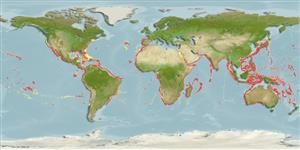>
Scombriformes (Mackerels) >
Trichiuridae (Cutlassfishes) > Aphanopodinae
Etymology: Benthodesmus: Greek, benthos = depth of the sea + Greek, desmos = bond, chain (Ref. 45335).
More on author: Günther.
Environment: milieu / climate zone / profondeur / distribution range
Écologie
marin benthopélagique; profondeur 200 - 850 m (Ref. 6181). Deep-water; 45°N - 36°S, 172°W - 175°E (Ref. 57013)
Western Atlantic: Canada (Ref. 5951), off Cape Hatteras, Gulf of Mexico, Suriname and southern Brazil. Eastern Atlantic: Gulf of Guinea to Angola. Western Indian Ocean: off Natal, South Africa (Ref. 11228). Western Pacific: Emperor Seamounts, Japan, Ryukyu Islands, Viet Nam, and the Sulu Sea. Indian Ocean: south of Java, Indonesia. Reported from British Columbia, Canada (Ref. 11980).
Taille / Poids / Âge
Maturité: Lm ? range ? - ? cm
Max length : 230 cm SL mâle / non sexé; (Ref. 10818); common length : 50.0 cm SL mâle / non sexé; (Ref. 10818)
Épines dorsales (Total) : 38 - 42; Rayons mous dorsaux (Total) : 78 - 89; Épines anales: 2; Rayons mous anaux: 69 - 76; Vertèbres: 122 - 132. Body silvery, jaws and opercle blackish. The inside of the mouth and gill cavities black.
Body shape (shape guide): eel-like; Cross section: compressed.
Mainly found over the continental slope (Ref. 27121). Juveniles mesopelagic (Ref. 6181, 58302).
Life cycle and mating behavior
Maturité | Reproduction | Frai | Œufs | Fécondité | Larves
Nakamura, I. and N.V. Parin, 1993. FAO Species Catalogue. Vol. 15. Snake mackerels and cutlassfishes of the world (families Gempylidae and Trichiuridae). An annotated and illustrated catalogue of the snake mackerels, snoeks, escolars, gemfishes, sackfishes, domine, oilfish, cutlassfishes,. scabbardfishes, hairtails, and frostfishes known to date. FAO Fish. Synop. 125(15):136 p. (Ref. 6181)
Statut dans la liste rouge de l'IUCN (Ref. 130435: Version 2025-1)
Menace pour l'homme
Harmless
Utilisations par l'homme
Pêcheries: bycatch
Outils
Articles particuliers
Télécharger en XML
Sources Internet
Estimates based on models
Preferred temperature (Réf.
123201): 7.3 - 15.7, mean 10.7 °C (based on 656 cells).
Phylogenetic diversity index (Réf.
82804): PD
50 = 0.5005 [Uniqueness, from 0.5 = low to 2.0 = high].
Bayesian length-weight: a=0.00046 (0.00020 - 0.00105), b=3.12 (2.92 - 3.32), in cm total length, based on LWR estimates for this (Sub)family-body shape (Ref.
93245).
Niveau trophique (Réf.
69278): 4.4 ±0.8 se; based on size and trophs of closest relatives
Résilience (Réf.
120179): Faible, temps minimum de doublement de population : 4,5 à 14 années (Assuming tmax>10).
Fishing Vulnerability (Ref.
59153): Very high vulnerability (90 of 100).
🛈
Nutrients (Ref.
124155): Calcium = 11.4 [5.0, 23.9] mg/100g; Iron = 0.299 [0.139, 0.683] mg/100g; Protein = 17.2 [15.5, 18.9] %; Omega3 = 0.221 [0.102, 0.516] g/100g; Selenium = 36 [14, 94] μg/100g; VitaminA = 6.53 [1.10, 34.95] μg/100g; Zinc = 0.244 [0.155, 0.404] mg/100g (wet weight);
